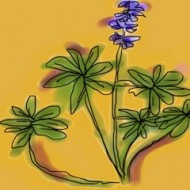The Dry Garden: Choosing fruit
Central to the promise of the California dream is the idea that you can reach out of your kitchen window and pluck a lemon. As we hit the limits of our water supply, that specter of home-grown fruit remains steadily possible, even a social ideal in the complex matrix of energy and water footprints.
In attaining it, the first hurdle is choice: What kind of lemon? What about oranges and limes? A modest lot in Los Angeles can produce full loads of not only citrus but also avocadoes, plums, apricots and nectarines. And don’t forget figs, pomegranates and apples. A long list only becomes longer when you consider the varieties and crosses available for each type of fruit. Valencia orange or blood? Eureka lemon or Meyer? Plum or “aprium”?
Choice of fruit trees is one of the most important decisions that you’ll make in a garden. You’ll be eating the …
The Dry Garden: Past as prologue
The West Adams Heritage Assn. celebrates the preservation of historic houses, but earlier this month, a markedly modern installation in Jefferson Park shared its “best garden” prize. Look at the home of Marina Moevs and Steve Peckman, and it’s obvious why: Few gardens could do a better job accenting but not overwhelming their lovingly restored Craftsman home.
After having taken pains to strip, then stain the clapboard for a weathered, muted effect, the first criterion that Moevs and Peckman put to a local garden designer was to keep the plants low. Herbs would be welcome, but they didn’t want any specimens taller than 3 feet. Furthermore, they didn’t want to water — or at least water often. Finally, they wanted to capitalize on a cash-for-grass program that offers rebates for replacing turf with a low-water alternative.
Click here to keep reading about the Peckman-Moevs project in The Dry Garden in …
Mr Smith goes to council
July 6: A laughing Los Angeles City Councilman Greig Smith wipes a tear from his eye as he taunts a Department of Water & Power representative over his success in flouting and, eventually, over-turning the department's hugely successful lawn watering ordinance. The Council is expected to vote in a watered-down ordinance soon. Click on the image to be taken to the city's On Demand video service.
In June 2009, an ordinance limiting lawn and garden watering with sprinklers to two days a week took effect in Los Angeles. Citywide water consumption dropped by more than 20%.
Yet, 13 months later, the ordinance that pushed Los Angeles to the fore of the Western water conservation movement is about to be gutted, having become collateral damage in a roiling brawl over rate hikes and green energy between the City Council and the mayor’s office.
On July 6, the City Council sent the …
The Dry Garden: In praise of Elmer Avenue
For all-around grooviness, a Sun Valley block that two years ago had no sidewalks, no street lights, no storm drains and no curbs should be next spring’s hot ticket on the home-tour circuit. Thanks to a newly completed makeover involving one federal bureau, one state agency, as many as six city agencies, three nonprofit groups and 24 homeowners, Elmer Avenue has become the Rolls-Royce of L.A.’s Green Street initiative.
Click here to keep reading in the Los Angeles Times about how the makeover of one block in the San Fernando Valley has resulted in a mass transition to drought tolerant gardens and the capture of 16 acre feet of storm water a year.…
The Dry Garden: Heirlooms by trial and error
A tomato left to rot in the garden last summer resulted this spring in my eating ripe homegrown heirloom tomatoes by Memorial Day instead of the normal harvest time around the Fourth of July. A fruit dropped in mulch sprouted in October rain, did nicely through winter storms and then, with some watering since May, the vines have been yielding what I’ve decided must be Cherokee Purple tomatoes for going on a month. In terms of flavor, they’re not Black Krims. No other tomato is. The word online is that Cherokee Purples rival Brandywines. That is true. In other words, they’re good enough that, with heirloom tomatoes of this quality costing $3 a pound in farmers markets, I thought I might be on to manna for readers. So I rang UC Davis’ C.M. Rick Tomato Genetics Resource Center to ask why every gardener in Southern California doesn’t plant tomatoes with …
« go back — keep looking »

